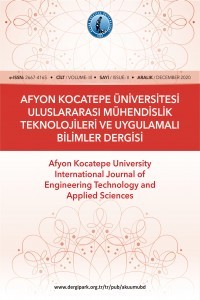Eğricik Dönüşümü Ayrıştırması Kullanılarak İki Sınıflı Motor Görüntüsü EEG Sinyallerinin Sınıflandırılması
Beyin bilgisayar arayüzü çalışmaları, temel olarak beyin sinyallerini toplamayı, analiz etmeyi ve kullanılmak üzere komutlara çevirmeyi amaçlamaktadır. Beyin sinyallerinin kontrol komutlarına çevrilmesinde elektroensefalogram (EEG) bir olanak sağlamaktadır. Deneğe özgü ve durağan olmayan yapısı nedeniyle EEG sinyallerinin sınıflandırılması zorlu görevlerdendir ve farklı yaklaşımlarla çalışmalar yapılmaktadır. Bu çalışmaların bir bölümü motor hareket hayali içeren beyin aktivitelerinin analizini kapsamaktadır. Bu makale, eğricik dönüşüm ayrıştırmasını kullanan iki sınıflı bir motor görüntüsü sınıflandırma algoritması sunmaktadır. Önerilen algoritma, BBA yarışması IV veri kümesi IIa kullanılarak gerçekleştirilmiştir. 22 kanaldan oluşturulan veri kümesinden, seçilen üç kanala (C3, Cz ve C4) ait EEG sinyalleri uygulamada kullanılmaktadır ve kanal sinyallerine 9-30 Hz frekans aralığı için eğricik dönüşümü uygulanmaktadır. Elde edilen dönüşüm katsayıları üzerinden standart sapma, ortalama değer ve log-varyans değerleri hesaplanarak özellik vektörleri oluşturulmaktadır. Doğrudan özellik vektörleri üzerinden ve özellik seçimi yapılarak karşılaştırmalı sınıflandırma işlemleri gerçekleştirilmektedir. Özellik seçimi için t-test yöntemi kullanılmakta, sınıflandırma işlemi k-NN sınıflandırıcısı kullanılarak gerçekleştirilmiştir.
Anahtar Kelimeler:
BBA, EEG, motor görüntüsü, eğricik dönüşümü, k-NN
Classification of Two-Class Motor Imagery EEG Signals Using Curvelet Transform Decomposition
Studies on brain computer interfaces primarily attempt to gather, analyze, and transfer brain signals into usable commands. The electroencephalogram (EEG) gives researchers the chance to convert brain signals into control instructions. Due to its subject-specific and non-stationary character, classification of EEG signals is a difficult issue, and research are being undertaken using methodological approaches. Analysis of the brain's activities, including motor imagery, is part of some research that have been done. This article presents a two-class motor imagery classification algorithm using curvelet transform decomposition. The proposed algorithm is carried out using the BCI competition IV dataset IIa. EEG signals of the three selected channels (C3, Cz and C4) from the data set composed of 18 channels are used in practice. Curvelet transform is applied to the selected channel signals for the 9-30 Hz frequency range. The feature vectors are created by calculating the standard deviation, mean and log-variance values over the obtained transform coefficients. Comparative classification processes are carried out over feature vectors with and without feature selection. The t-test method is used for feature selection, and the classification process is carried out using the k-NN classifier.
Keywords:
BCI, EEG, motor imagery, curvelet transform, k-NN,
___
- Candes, E.J., and Donoho, D.L., 2000. Curvelets: A surprisingly effective nonadaptive representation for objects with edges. Curves and Surfaces. 105-120.
- Candès E., Demanet L., Donoho D., and Ying L., 2006. Fast Discrete Curvelet Transforms. Multiscale Modeling and Simulation, 5(3), 861-899.
- Constantin A., and Danyluk A., 2007. A Brain-Computer Interface for the Classification of Motor Imagery. Bachelor thesis, Williams College, USA.
- Curran E.A., and Stokes M.J., 2003. Learning to control brain activity: A review of the production and control of EEG components for driving brain–computer interface (BCI) systems. Brain and cognition. 51(3), 326-336.
- Garrett D., Peterson D.A., Anderson C.W., and Thaut M.H., 2003. Comparison of linear, nonlinear, and feature selection methods for EEG signal classification. IEEE Transactions on neural systems and rehabilitation engineering. 11(2), 141-144.
- Guger C., Allison B.Z., and Edlinger G., 2014. Brain-Computer Interface Research: A State-of-the-Art Summary 2, Springer, New York, NY, USA, 2014.
- Ramoser H., Muller-Gerking J., and Pfurtscheller G., 2000. Optimal spatial filtering of single trial EEG during imagined hand movement. IEEE transactions on rehabilitation engineering. 8(4), 441-446.
- Vallabhaneni A., Wang T., and He B., 2005. Brain-computer interface. In Neural engineering, 85-121.
- Wang Y., Zhang Z., Li Y., Gao X., Gao S., and Yang F., 2004. BCI competition 2003-data set IV: an algorithm based on CSSD and FDA for classifying single-trial EEG. IEEE Transactions on Biomedical Engineering. 51(6), 1081-1086.
- Wang H., Zhang Y., Waytowich N.R., Krusienski D.J., Zhou G., Jin J., ... and Cichocki A., 2016. Discriminative feature extraction via multivariate linear regression for SSVEP-based BCI. IEEE Transactions on Neural Systems and Rehabilitation Engineering. 24(5), 532-541.
- Yang Y., Chevallier S., Wiart J., and Bloch I., 2017. Subject-specific time-frequency selection for multi-class motor imagery-based BCIs using few Laplacian EEG channels. Biomedical Signal Processing and Control. 38, 302-311.
- Zhang Y., Wang Y., Jin J., and Wang X., 2017. Sparse Bayesian learning for obtaining sparsity of EEG frequency bands-based feature vectors in motor imagery classification. International journal of neural systems. 27(2), 1650032.
- Zhang Y., Wang Y., Zhou G., Jin J., Wang B., Wang X., and Cichocki A., 2018. Multi-kernel extreme learning machine for EEG classification in brain-computer interfaces. Expert Systems with Applications. 96, 302-310.
- İnternet kaynakları
- 1- https://www.bbci.de/competition/iv/
- 2- https://www.bbci.de/competition/iv/desc_2a.pdf
- Yayın Aralığı: Yılda 2 Sayı
- Başlangıç: 2018
- Yayıncı: Afyon Kocatepe Üniversitesi
Sayıdaki Diğer Makaleler
Kolesterol Tayini için Biyosensör Geliştirilmesi
Edanur TURGUT, Züleyha DEĞİRMENCİ
Pankreas Kanserinin Erken Evrelerde Teşhisi için Yapılan Biyosensör Çalışmaları
Mermer Türlerinin Makine Öğrenmesi Teknikleri Kullanılarak Sınıflandırılması
Spoyler Tasarımı ve Kullanılan ABS ve Karbon Fiber Malzemelerin Analizi
Mehmet ÇAKMAKKAYA, Furkan SOYLU
Leonarditin Hidrosiklon ile ön Zenginleştirilmesinin Alkali Liç Verimi Üzerine Etkisi
Derin öğrenme tabanlı Elektrikli Ev Aletleri Veri Setinin Sınıflandırılması
